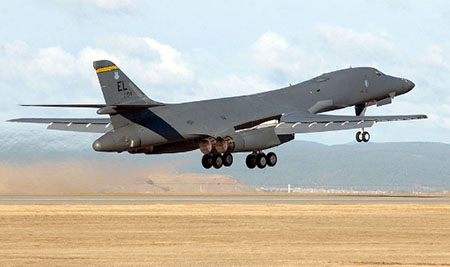by WorldTribune Staff, February 4, 2024
The United States on Friday launched a series of coalition airstrikes targeting Iran-backed militias in Syria and Iraq.
More than 125 precision munitions were used in the strikes, which hit more than 85 targets, the Pentagon said.

On Saturday, American and allied forces hit 36 Houthi targets at 13 locations in Yemen.
Team Biden said it launched the airstrikes in a bid to deter further attacks against American forces after three U.S. troops were killed in a drone strike in Jordan.
The attacks on Friday included strikes by long-range B-1 bombers flown from the U.S.
Human Events editor Jack Posobiec noted in a Telegram post: “Why do we have 3,000 troops in harm’s way in the Middle East when we can launch bombers from the U.S. to hit Iranian proxy forces?”
Related: Bombs away: It’s ‘déjà vu all over again’, February 1, 2024
The Pentagon said the U.K., Australia, Bahrain, Canada, Denmark, the Netherlands, and New Zealand were involved in Saturday’s strikes against Houthi targets, saying they were in response to the Iran-backed group’s attacks targeting international shipping vessels.
U.S. Central Command said strikes on Saturday targeted “multiple underground storage facilities, command and control, missile systems, UAV storage and operations sites, radars, and helicopters” used by the Houthis.
The Biden team said the attacks could extend for days and would be coupled with economic sanctions and diplomacy that is aimed at safeguarding American forces while not pushing the U.S. toward direct confrontation with Iran.
“Our response began today,” said President Biden Friday afternoon. “It will continue at times and places of our choosing.”
American forces targeted Iran’s Islamic Revolutionary Guard Corps’ (IRGC) Quds Force and affiliated militia groups that have facilitated attacks on U.S. and coalition forces in the Middle East.
U.S Central Command posted a statement on social media:
At 4:00 p.m. (EST) Feb. 02, U.S. Central Command (CENTCOM) forces conducted airstrikes in Iraq and Syria against Iran’s Islamic Revolutionary Guards Corps (IRGC) Quds Force and affiliated militia groups. U.S. military forces struck more than 85 targets, with numerous aircraft to include long-range bombers flown from United States. The airstrikes employed more than 125 precision munitions. The facilities that were struck included command and control operations centers, intelligence centers, rockets, and missiles, and unmanned aerial vehicle storages, and logistics and munition supply chain facilities of militia groups and their IRGC sponsors who facilitated attacks against U.S. and Coalition forces.
The U.S. attacks hit targets at seven locations, four in Syria and three in Iraq. Among the targets were command and control centers, intelligence centers, rockets and missile and drone storage facilities used by militias and their Iranian sponsors, the Pentagon said.
Officials deemed the strikes successful but didn’t provide details. “We’re going to let the sun come up and we’ll be able to start to make some better determinations in terms of our damage assessment,” said Army Lt. Gen. D.A. Sims in a briefing for reporters Friday. “We feel pretty confident,” he added of the results of the strikes.
Bombing is not diplomacy. Bombing is neither a strategy nor a simple exercise in virtue signaling.
Bombing is an act of war. Bombing does not contain conflict, nor does bombing deter an opponent from future action.
If anything, bombing escalates tension and leads to all-out…
— Douglas Macgregor (@DougAMacgregor) February 2, 2024
Quality Resource for Citizen Journalists
